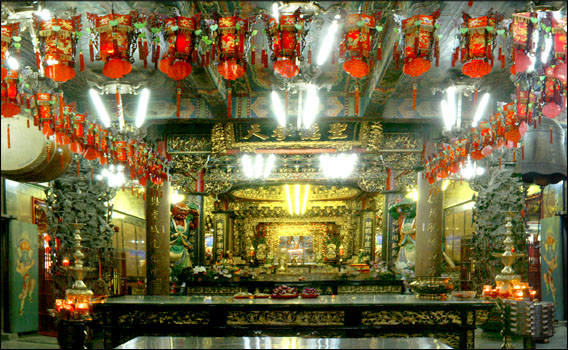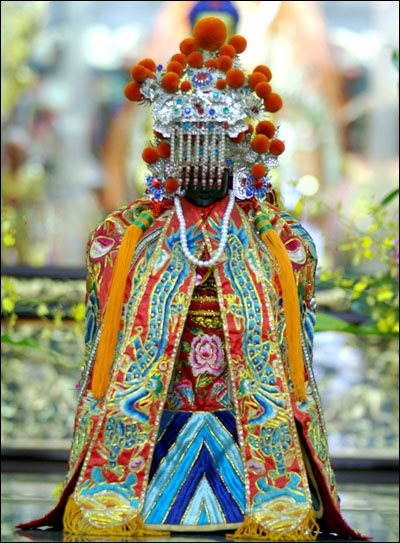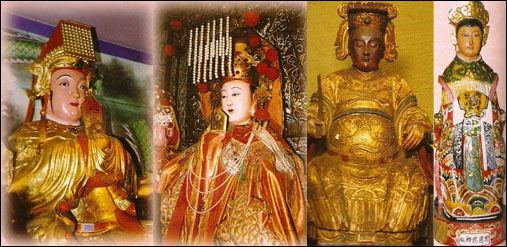The History of Temple
Peitsie Fort
In the beginning Peitsie belonged to the Pepo people who lived in Peitsie village. The people of Zhangzhou, Mr. Lin Cheng-zu, Mr. Liao Fu-chun and others crossed the strait to Taiwan in 1734 (the 12th year of the Yongzheng regime, Qing dynasty). In 1750 (the 15th year of the Qianlong regime, Qing dynasty) with gov-ernment approval, they started to cultivate this area.
They maintained Peitsie’s aboriginal name.
According to the record of The History of Tamshui: Peitsie Fort, Peitsie, which had 17 villages,was located in the northeast of Tamshui town (Zhuqian town).


| Galaya village(加蚋仔莊) | at a distance of 15 li from Tamshui town hall |
| Gangyacui village(港仔嘴莊) | at a distance of 20 li from Tamshui town hall |
| Aubo village(後埔莊) | at a distance of 20 li from Tamshui town hall |
| Xiaou village(社後莊) | at a distance of 26 li from Tamshui town hall |
| Beiyanakeju village(柏仔林溪州莊) | at a distance of 10 li from Tamshui town hall |
| Xibogi village(新埔墘莊) | at a distance of 10 li from Tamshui town hall |
| Yinshuaya village(員山仔莊) | at a distance of 28 li from Tamshui town hall |
| Bangliao village(枋寮莊) | at a distance of 17 li from Tamshui town hall |
| Kimjiouka village(芎蕉腳莊) | at a distance of 18 li from Tamshui town hall |
| Namshiga village(南勢角莊) | at a distance of 20 li from Tamshui town hall |
| Gulunlan village(龜崙蘭莊) | at a distance of 17 li from Tamshui town hall |
| Ganamagia village(柑仔陂莊) | at a distance of 27 li from Tamshui town hall |
| Huixiu village(火燒莊) | at a distance of 12 li from Tamshui town hall |
| Wanlimya village(員林仔莊) | at a distance of 15 li from Tamshui town hall |
| Lenzuikin village(冷水坑莊) | at a distance of 26 li from Tamshui town hall |
| Dinliaokin village(藤寮坑莊) | at a distance of 26 li from Tamshui town hall |
| Daianliao village(大安寮莊) | at a distance of 27 li from Tarnshui town hall |
| (Note: 1 kilometer = 2 li) | |
Most of the villages were located in Wanhua district in Taipei City, and in Zhonghe , Yonghe and Tucheng areas in Taipei County. However, there were exceptions with Aubo village, Xiaou village, Gangyacui village and Xibogi village, which were located in Banqiao.
Mr. Lin Cheng-zu and Mr. Liao Fu-chun were the first two immigrants who cultivated Banqiao area. Latecomers had to contractually rent farm land from Mr. Lin Cheng-zu, which was paid on an annual basis. The land was used to build houses for their dwelling. Mr. Lin Cheng-zu was called ‘the great landed proprietor in Peitsie Fort’ and Mr. Liao Fu-chun was called ‘the great landholder in Banqiao’.
The private revenues were abandoned when the Japanese took over Taiwan.
Mr. Lin Cheng-zu ‘the great landed proprietor in Peitsie Fort’, was also a distant relative of Mr.Lin Guo-hua, the famous owner of the Lins’ Family Residence. Mr. Lin Guo-hua’s father, Mr. Lin Ping-hou had 5 sons. Mr. Lin Ping-hou gave his sons a 5-character Chinese idiom “Yin Shui Ben Si Yuan” as a family motto, witch means be grateful all the time; Each character represented each of his sons. The third son, Mr. Lin Guo-hua, and the fifth son, Mr. Lin Guo-fang, were good businessmen. Therefore, they named their company Lin Ben Yuan. Some people mistook the name of company as the name of the owner.
During the Qing period, the Lins were the richest people in Taiwan.
Mr. Lin Guo-fang donated money generously to build the Cihui Mazu temple in 1854.
Mazu, “Heavenly Holy mother”




